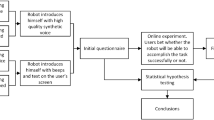Abstract
The orientation of conversational robots to face their interlocutors is essential for natural and efficient Human-Robot Interaction (HRI). In this paper, progress towards this objective is presented: a service robot able to detect the direction of a user, and orient itself towards him/her, in a complex auditive environment, using only voice and a 3-microphone system. This functionality is integrated within Spoken HRI using dialogue models and a cognitive architecture. The paper further discusses applications where robotic orientation benefits HRI, such as a tour-guide robot capable to guide a poster session and a “Marco Polo” game where a robot aims to follow a user purely by sound.
Access this chapter
Tax calculation will be finalised at checkout
Purchases are for personal use only
Preview
Unable to display preview. Download preview PDF.
Similar content being viewed by others
References
Avilés, H., Alvarado-González, A.M., Venegas, E., Rascón, C., Meza, I., Pineda, L.A.: Development of a tour–guide robot using dialog models and a cognitive architecture. In: Kuri-Morales, A., Simari, G. (eds.) IBERAMIA 2010. LNCS (LNAI), vol. 6433, pp. 512–521. Springer, Heidelberg (2010)
Faller, C., Merimaa, J.: Source localization in complex listening situations: Selection of binaural cues based on interaural coherence. The Journal of the Acoustical Society of America 116(5), 3075–3089 (2004)
Fong, T., Nourbakhsh, I., Dautenhahn, K.: A survey of socially interactive robots. Robotics and Autonomous Systems 42(3-4), 143–166 (2003)
Hjelmås, E., Low, B.K.: Face detection: A survey. Computer Vision and Image Understanding 83(3), 236–274 (2001)
Horchler, A.D., Reeve, R.E., Webb, B., Quinn, R.D.: Robot phonotaxis in the wild: a biologically inspired approach to outdoor sound localization. In: Sound Localization, 11th International Conference on Advanced Robotics (ICAR 2003), pp. 1749–1756 (2003)
Liu, R., Wang, Y.: Azimuthal source localization using interaural coherence in a robotic dog: modeling and application. Robotica First View, 1–8 (2010)
Lockwood, M.E., Jones, D.L., Bilger, R.C., Lansing, C.R., O’Brien Jr., W.D., Wheeler, B.C., Feng, A.S.: Performance of time- and frequency-domain binaural beamformers based on recorded signals from real rooms. Journal of the Acoustical Society of America 115(1), 379–391 (2004)
Meza, I., Salinas, L., Venegas, E., Castellanos, H., Chavarria, A., Pineda, L.A.: Specification and evaluation of a spanish conversational system using dialogue models. In: Kuri-Morales, A., Simari, G. (eds.) IBERAMIA 2010. LNCS (LNAI), vol. 6433, pp. 346–355. Springer, Heidelberg (2010)
Mohan, S., Lockwood, M.E., Kramer, M.L., Jones, D.L.: Localization of multiple acoustic sources with small arrays using a coherence test. Journal of the Acoustical Society of America 123(4), 2136–2147 (2008)
Murray, J.C., Erwin, H., Wermter, S.: Robotics sound-source localization and tracking using interaural time difference and cross-correlation. In: AI Workshop on NeuroBotics (2004)
Murray, J.C., Erwin, H.R., Wermter, S.: Robotic sound-source localisation architecture using cross-correlation and recurrent neural networks. Neural Networks 22(2), 173–189 (2009)
Nakadai, K., Okuno, H.G., Kitano, H.: Real-time sound source localization and separation for robot audition. In: Proceedings IEEE International Conference on Spoken Language Processing, pp. 193–196 (2002)
Pineau, J., Montemerlo, M., Pollack, M., Roy, N., Thrun, S.: Towards robotic assistants in nursing homes: Challenges and results. Robotics and Autonomous Systems 42(3-4), 271–281 (2003)
Pineda, L.A., Meza, I., Salinas, L.: Dialogue model specification and interpretation for intelligent multimodal HCI. In: Kuri-Morales, A., Simari, G. (eds.) IBERAMIA 2010. LNCS (LNAI), vol. 6433, pp. 20–29. Springer, Heidelberg (2010)
Saxena, A., Ng, A.Y.: Learning sound location from a single microphone. In: ICRA 2009: Proceedings of the 2009 IEEE International Conference on Robotics and Automation, pp. 4310–4315. IEEE Press, Piscataway (2009)
Schmidt, R.: Multiple emitter location and signal parameter estimation. IEEE Transactions on Antennas and Propagation 34(3), 276–280 (1986)
Smith, M., Kim, K., Thompson, D.: Noise source identification using microphone arrays. Proceedings of the Institute of Acoustics 29(5) (January 2007)
Stiefelhagen, R., Ekenel, H.K., Fugen, C., Gieselmann, P., Holzapfel, H., Kraft, F., Nickel, K., Voit, M., Waibel, A.: Enabling multimodal human-robot interaction for the karlsruhe humanoid robot. IEEE Transactions on Robotics 23(5), 840–851 (2007)
Tanawongsuwan, R., Stoytchev, A., Stoytchev, E., Essa, I.: Robust tracking of people by a mobile robotic agent. Tech. rep. (1999)
Valin, J., Rouat, J., Michaud, F.: Enhanced robot audition based on microphone array source separation with post-filter. In: Proc. IEEE/RSJ Int. Conf. Intelligent Robots and Systems, pp. 2123–2128 (2004)
Wang, D., Brown, G.J.(eds.): Computational auditory scene analysis: Principles, Algorithms, and Applications. IEEE Press/Wiley-Interscience (2006), http://www.casabook.org/
Author information
Authors and Affiliations
Editor information
Editors and Affiliations
Rights and permissions
Copyright information
© 2010 Springer-Verlag Berlin Heidelberg
About this paper
Cite this paper
Rascón, C., Avilés, H., Pineda, L.A. (2010). Robotic Orientation towards Speaker for Human-Robot Interaction. In: Kuri-Morales, A., Simari, G.R. (eds) Advances in Artificial Intelligence – IBERAMIA 2010. IBERAMIA 2010. Lecture Notes in Computer Science(), vol 6433. Springer, Berlin, Heidelberg. https://doi.org/10.1007/978-3-642-16952-6_2
Download citation
DOI: https://doi.org/10.1007/978-3-642-16952-6_2
Publisher Name: Springer, Berlin, Heidelberg
Print ISBN: 978-3-642-16951-9
Online ISBN: 978-3-642-16952-6
eBook Packages: Computer ScienceComputer Science (R0)




